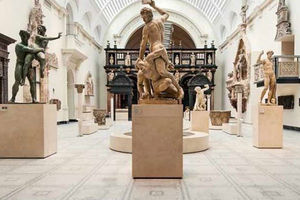
Mr Charles Onyango-Obbo
At least 39 cultural artefacts repatriated from the United Kingdom arrived in Uganda on the weekend.
The artefacts, which were taken during the colonial period and were held in the UK for 100 years, included the Bunyoro cultural drum, decorated pots from Ankole, a Lubaale vessel from Buganda, and a headdress made of human hair acquired from Lango.
The artefacts are not even a drop in the vast ocean of the more than 500,000 artefacts looted or bought at forced low prices, that are being held in Europe alone.
If manuscripts, photographs, plants, insects, and other objects are added, the looted African cultural, knowledge, and nature treasures in Western archives, stores, and gardens are in several millions.
In the last five years, some looted artefacts have been returned to Africa in a trickle. However, we have not yet got down to full grappling with why they were looted in the first place.
It all speaks to an element of the evil genius of the European colonial project. The little-hidden secret of the European’s success in subjugating and dominating Africans and other peoples wasn’t their superior guns, the greed of local rulers that saw them trade trinkets and whisky for territory, or the “backward’ technology of the “natives”.
It was their understanding of the centrality of the spiritual and culture in Africans’ worldview, sense of place, and how much purpose they drew from those sources.
Benin City was once the capital of a Benin Empire located in what is now southern Nigeria. The Benin Empire was one of the oldest and most highly developed states in West Africa, dating back to the 11th century.
The wall network of Benin City was collectively four times longer than the Great Wall of China and consumed roughly 100 times more material to build than the Great Pyramid of Giza in Egypt.
Benin City was also notably among the first urban centres to have a likeness of street lighting. There were large metal lamps that burned palm oil, standing many feet high, placed around the city.
In an 1897 resistance to colonial encroachment, it killed some British soldiers and their African support staff. The British sent a punishing expedition that burnt this great city to the ground and wiped it off the map.
In his documentary “Africa’s Great Civilisations”, American scholar and literary critic Henry Louis Gates Jr, makes the point that it wasn’t the military defeat that finished off Benin City. It was the looting of its cultural assets.
British troops ransacked the royal palace, stealing between 3,000 and 5,000 objects of significant cultural value from the palace and other places. In Benin City and other places on the continent, because the authority of gods, the spirits of the ancestors, and the connections of families to their lineage lay in the sculptures and masks, their seizure destroyed the people’s souls.
The British had to be greater than your gods if they could carry away the objects that enshrined their power without retribution. And your ancestors had nothing on them if they could cart away their masks with impunity. The people were lost, having no reference or rallying point to fight back. So, it wasn’t the gun that did it. It was the loss of political and cultural artefacts.
The colonialists organised further expeditions to seize these cultural artefacts. These extended to looting sacred shrines, and even cemeteries. History records that many African people were killed defending their cultural heritage.
The lessons were not lost on post-independence African leaders. Following the 1966 clash between Milton Obote’s (UPC government and Buganda kingdom, which led to the abolition of kingdoms, the home of Kabaka Freddie Mutesa was ransacked and priceless artefacts taken away. Royal regalia were destroyed, including the ceremonial Mujaguzo drums.
In 1993, following the restoration of kingdoms, only the Ankole house wasn’t revived. The public reason was that the overwhelming people of Ankole opposed the restoration of what would have been a minority Hima kingdom.
The cynics held that President Yoweri Museveni, being from Ankole, saw himself as the king of kings (Ssebagabe), and couldn’t stand to be a subject of the Omugabe in his backyard. And that time, it was reported that the government had seized the Ankole royal drums from the museum.
The colonialists could kill or buy off rebellious African chiefs. They could burn shrines, prohibit African religions, and replace them with Western Christianity.
But replacing the spiritual connections, and centuries-old culture, that was always going to be the toughest one. They never totally succeeded, but they didn’t have to. Even at 50 percent, it was a great victory.
The return of the artefacts to Uganda, like to the rest of Africa, is not that momentous. After more than 200 years in some cases, the bonds that tie us to that past have been broken beyond repair. The coloniser won that round.
Mr Onyango-Obbo is a journalist, writer and curator of the “Wall of Great Africans”.
X: @cobbo3



